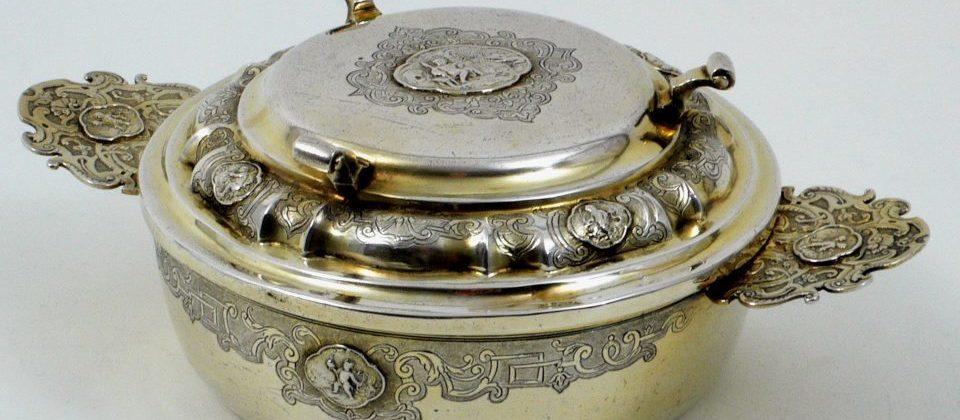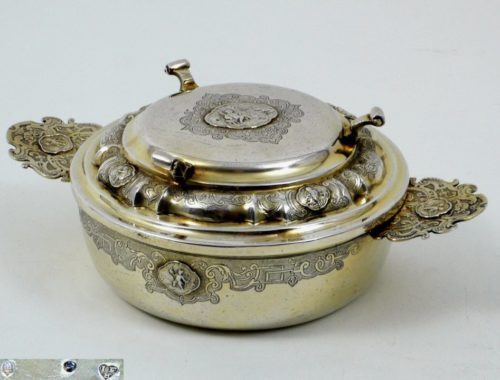Object Number: #352
Augsburg 1729/32
Johann Erhard II Heuglin (1687-1757)
City’s hallmark: a “pyr” for Augsburg, 1732 (Seling 2007, Nr. 1710)
Maker’s mark: monogram “IE/H“ in a heart-shaped shield for Johann Erhard II Heuglin (Seling Nr. 2096)
Height: 7, 8 cm (2, 75 in.); Diam.: 21 cm (8, 26); Weight: 440 gr.
Detailed Information
Silver Gilt German Porringer and Cover (Ecuelle)
The present object is a silver gilt porringer with cover (French: écuelle), a lidded, shallow bowl, from Augsburg, worked in excellent Régence style. The round bowl is standing on a shallow ground and its corpus is adorned under the rim with a running strapwork-bordure. In the center on the front and the backside there is a medallion with putti. The horizontal and cast handles are richly decorated with chased foliage. A medallion is on each upper side of the handle and creates a harmonic effect with the décor of the bowl. The cover is in different levels formed and is decorated by a running ornamental foliage band. In there, four medallions with putti in several scenes. In the middle of the cover, on the upper side, a chased cartouche and a bigger medallion with a scene of sitting putto representing an Allegory of Africa. Three small scrolls are used as feet of the lid, so as to use it as a plate or standing plate for the bowl.
The Silver Ecuelle/Porringer
Écuelle was used at the table but above all during the ceremonial morning toilette for the breakfast serving. The object is thus mostly an important part of a toilette service. Écuelle was also given as a gift to a young mother; this is why it is also called in German “Wöchnerinnenschüssel“. Vessels of similar form are to be found in iconographical and written sources since the Renaissance.
This name of this three-feet vessel was given after the porridge that new-borns and women who have recently given birth ate (“Wöchnerin” in German). Bowls for porridge for the child or the woman were made in wealthy families from metal, mostly silver.
An écuelle, like this present one, was often accompanied by a matching stand (s. for instance, Smithsonian Design Museum – Cooper Hewitt, Object ID 18429523).
Maker
Johann Erhard II Heuglin, Protestant, silver worker and master for gilding, was baptised in 1687 as son of the goldsmith Johann Erhard I Heuglin. He became a master maker in 1717 and was married on the same year to Anna Maria Herz. In 1731 he requested the council to take permission to engage as an apprentice the son of the merchant Hornung, in order to be supported for the realization of his commands.
Johann Erhard Heuglin was among the most famous in the field, the most renowned member of his well-recognized family of silversmiths during the first half of eighteenth century. His clients were mostly aristocrats. Heuglin was made goldsmith to Emperor Charles VI (1685-1740) in 1721 and also worked for Charles’s daughter, Empress Maria Theresa of Austria (1717-1780).
From his atelier are still kept today mostly big toilette and travel services or parts of them as well as precious tableware objects in international museums (e.g. in The Clark Art Institute, in Smithsonian Design Museum, in The Metropolitan Museum of Art, in Victoria & Albert Museum)
Literature
Seling, Helmut, Die Augsburger Gold- und Silberschmiede 1529-1868, Bd. I-III, München: Beck Verlag, 1980-2007



